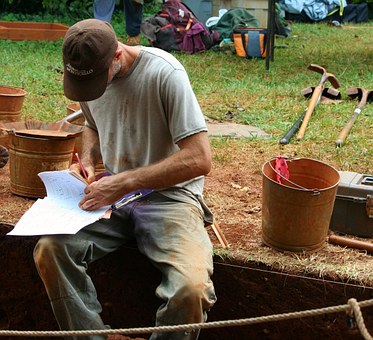Charity’s Column: I can dig it

My dog Mabel is a canine archaeologist.
She’ll dig in the yard, stick her snout as far into her test-hole as she can shove it, snort violently, and then dig even more furiously. I think she’s on to something, because the archaeologists who dug up the yard at Sylvester Manor (“Uncovering the enduring past,” July 4) a couple of weeks ago were also having the time of their lives, and were as proud of the ring, spoon, pipe stem and miscellaneous other artifacts they found as Mabel is of that sharp brownish thing she had in her mouth.
I’m generally looking up — for the water view, to gaze at stars, to see if there are fledglings in an osprey nest. Now I’m thinking something just as interesting may be below my feet, and if I don’t grab a trowel and have at it, I’ll never know. Who (besides Mabel) knows what history lies beneath the topsoil of my own yard?
Most rural Islands cannot claim to have even one Egyptian archaeologist; Shelter Island is fortunate to have two; Jack Josephson and Steve Harvey. These are people who know their way around a dig. I learned recently that each of them has found artifacts in their own Shelter Island yards.
Jack, known for his work on Egyptian art, was approached by a Southampton-based archaeologist looking for native American remains. He was happy to agree to let the guy dig a hole down by the Creek, and sure enough he found native American middens (aka an ancient garbage pile) including age-old scallop and clam shells.
Steve Harvey, who has worked with excavations including at the Tomb of Queen Tetisheri at the sacred site of Abydos, said he found pottery and glass items related to the 18th- and 19th-century lives of the Havens descendants a few feet from his house in the Center.
Valerie Shepherd’s family is in the business of digging in people’s yards, a livelihood that has put them up close and personal with the history of the Island. She told me that Big Gene and Little Gene Shepherd, who have been digging foundations and burying cesspools for decades, have found so much old, interesting stuff that they have created a museum of the engines and mechanical devices they’ve unearthed over the years.
A few years back, Gene (the younger) found a 1915 “hit, and miss” engine while installing a cesspool, when his backhoe uncovered the corner of something hard. He then dug by hand, and found the brass tag that indicated the brand of engine — Witte. Gene said that’s how people on Shelter Island used to dispose of things. “They probably had it sitting in the yard, and when they dug a cesspool, they just pushed it right in.”
Another Shepherd family find was the 1910 Lathrop engine that Gene pulled out of the muck near Coecles Harbor. A little investigation and some long memories produced the facts. The engine came from the South Ferry’s launch, a dory called The Fanny, that towed the barge back in the days when the South Ferry was a tandem operation.
The engine had been in Frank Beckwith’s old boat and when that vessel sank in the 1938 hurricane it was left at the bottom until Gene dug it up.
Ever heard tell of the grand Prospect Hotel, that once stood proudly on the hill above the North Ferry terminal? Stella Lagudis, general manager of the Shelter Island Heights Property Owners Association, said while attempting to bury some overhead power lines that supply the Heights wastewater treatment plant in 2018, they found the hotel’s foundation.
It was still intact after the fire that destroyed the building in 1942 and apparently had been buried instead of demolished. They decided to move the lines to another spot.
Reed Karen is a town building inspector, so when someone on Shelter Island wants to dig a big hole for a foundation or pool, he’s likely to know about it. He’s less likely to know whether the digging has unearthed any Island history because a homeowner with a building project is not always eager to dig up the past.
As a kid, he had his own brush with fraught archaeology. He learned that very old human remains had been found in the basement of his family’s home about a decade before they moved in.
“Our house was next door to a house that was known to be part of the underground railroad,” Reed said. “When the previous owners were doing a renovation in the early 60s, they opened up a wall in the basement and found a secret compartment with a skeleton inside. They think it may have been someone who had died on the way to Canada. And no, my family did not consider doing any renovations down there.”
In October 2003, Shelter Island Police Officer Walter Richards found human bones while digging the foundation for a barn near his house. He suspected the bones were human and reported his find. It turned out the skeletons of at least five individuals were in the earth on his property.
They were later identified as the remains of Native Americans, probably Manhanset people. Officials estimated the bones were several hundred years old at least, and possibly much older — an event that reminded everybody that Nathanael Sylvester was another person who came to Shelter Island from somewhere else, fell in love with the place and decided to move here.
I’m grateful to the people who dug in their yards, found some history, and shared it. And if we find something interesting down there, Mabel and I will let you know.

